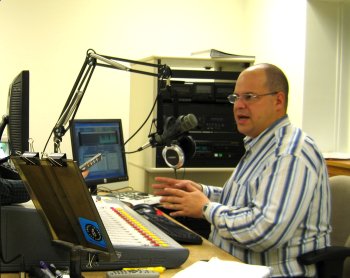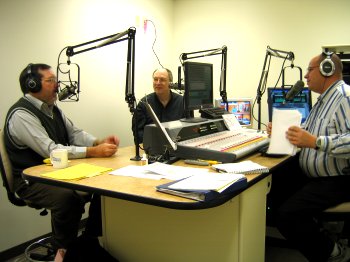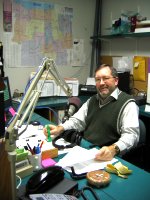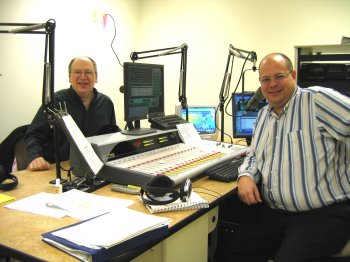- By Dan Veaner
- Around Town
 Print
Print
Monday, November 20, 2006: If you were listening to the Morning News Watch on WHCU you probably noticed something different -- or maybe not! It's radio, after all, and what you couldn't see is that Dave Vieser was broadcasting from a new studio. "Everything is new," Vieser says. "From the CD players to the audio board that we use to send the signal out, to the microphones. Even the phone lines are brand new."

Dave Vieser in the new WHCU Studio
Since Saga Communications, the parent company of Cayuga Radio Group bought Eagle Broadcasting about a year and a half ago, they have been upgrading the station's equipment including computer and phone systems. Recently the Warren Road facility was expanded, and WHCU has begun its move into the new studio. "The entire place is going to be renovated," says General Manager Susan Johnston. "We'll be able to do a lot more, once everything's done. We're very excited about it. It's an upgrade in everything."
With the newly built studios and the eventual renovation of the old ones Cayuga Radio Group will have plenty of room for expansion. Johnston says that will mean that WNYY will be able to produce local progressive talk programming, to add to the national programming they currently carry.

Geoff Dunn (left) chats with Dave
Saga sent an engineer to assist Cayuga Radio Group's Chief Engineer Jason Gordetzer and Vieser as they made the move. Normally the station relies on its computer to know when to bring in national programming, and when to insert local spots. "On Saturday our programming was done manually," Vieser says. "We didn't have computers. So we actually ran WHCU like they did in the old days, back in the '70s. At 9:30 pm we flipped the switch and it's been running ever since. And running very, very well."
The studio isn't 100% finished yet. You have to be careful not to trip on a wire that runs along the floor and out the door, because it controls the satellite receiver that brings national programming like Rush Limbaugh and Bill O'Reilley into the station. And window blinds and something to hang on the walls are still coming. But all the equipment is new, and the layout is simpler and more efficient. "Saga does it right," Johnston says. "They make sure we have all the equipment to do it right going into the future."
Geoff Dunn will be the next to move as they prepare the News Room to move, around the end of the month. You can see the old WHCU studio through a window across the hall from the current News Room. Dunn broadcasts the news there, then walks down the hall to the new studio for a segment in which he and Vieser talk about the news. The new News Room is right next to the new studio with a window between them so Dunn will be able to stay in place.
Johnston notes that the upgrades not only increase the technical quality of Cayuga Radio Group's broadcasting, and eventually their ability to produce more local programming, but also the reliability. Backup generators mean that the stations can remain on the air during emergencies, and she says this is important to local listeners.


Geoff Dunn broadcasts from the old Newsroom (left)
while the new one (at right) is made ready
In many ways the old and new studios are like night and day. The old studio was dark and crowded with Vieser sitting on a higher level than his guests. The new studio is bright and airy, with everyone on the same level. It is almost as if the equipment is sitting on a large dining room table, making conversation more natural. And Vieser says not everything is in the same place as it was in the old studio. After the first hour on Monday he was asked if he'd pressed any wrong buttons. "Not yet," he said. "But I'm about to!"
----
v2i45

Dave Vieser in the new WHCU Studio
Since Saga Communications, the parent company of Cayuga Radio Group bought Eagle Broadcasting about a year and a half ago, they have been upgrading the station's equipment including computer and phone systems. Recently the Warren Road facility was expanded, and WHCU has begun its move into the new studio. "The entire place is going to be renovated," says General Manager Susan Johnston. "We'll be able to do a lot more, once everything's done. We're very excited about it. It's an upgrade in everything."
With the newly built studios and the eventual renovation of the old ones Cayuga Radio Group will have plenty of room for expansion. Johnston says that will mean that WNYY will be able to produce local progressive talk programming, to add to the national programming they currently carry.

Geoff Dunn (left) chats with Dave
Saga sent an engineer to assist Cayuga Radio Group's Chief Engineer Jason Gordetzer and Vieser as they made the move. Normally the station relies on its computer to know when to bring in national programming, and when to insert local spots. "On Saturday our programming was done manually," Vieser says. "We didn't have computers. So we actually ran WHCU like they did in the old days, back in the '70s. At 9:30 pm we flipped the switch and it's been running ever since. And running very, very well."
The studio isn't 100% finished yet. You have to be careful not to trip on a wire that runs along the floor and out the door, because it controls the satellite receiver that brings national programming like Rush Limbaugh and Bill O'Reilley into the station. And window blinds and something to hang on the walls are still coming. But all the equipment is new, and the layout is simpler and more efficient. "Saga does it right," Johnston says. "They make sure we have all the equipment to do it right going into the future."
| Monday morning I tumbled out of bed early to get to Cayuga Radio Group. I was scheduled to be the first guest in WHCU's new studio, to talk about Lansing news. It was still dark when I got there at 6:30, and I could see the back of Dave's head through the window in the new studio. As I passed the old studio I saw Geoff Dunn reporting the news, then went into the new wing where Dave was taking a quick break between segments. I had been interviewed in the old studio, a crowded, dark room where the host sits on a raised platform while the guests sit at a kind of counter below. The first thing I noticed as I walked into the new studio was how bright it is. And while it's not actually that much bigger than the old room, it seems much larger with an attractive, uncluttered layout.  I had the pleasure of being the first person interviewed in the new WHCU studio The centerpiece is a large table with the mixing board, satellite control, CD players and other equipment efficiently placed. Three adjustable arms hold microphones, one for Dave and two for guests. As Dave interviewed me I could see him across the table, and the feeling was casual and conversational. Vieser likes that aspect of his new digs. "When I just interviewed you it was nice," he said. I felt like I was talking with you, not looking down on you like I was in the old studio." Since taking over the show Vieser has used the station's state of the art phone system for many of his interviews. The quality is quite good, and you often can't tell that a guest is on the phone. I have enjoyed being interviewed on the phone, but there is an unquestionable immediacy and intimacy talking to Dave across the table. Vieser says the station will better facilitate live interviews, but he will continue to take advantage of the flexibility phone interviews have afforded the show. "It's allowing for both," he says. "Because we do want to have the ability to have people in the studio, but the reality is that interviews are done quicker and a little more efficiently by phone." After my interview, I turned the tables, interviewing Vieser for this article. Despite the extra work getting everything ready while keeping the station on the air, he was excited to be in the new space. "When you do this you're bound to have a couple of things go wrong," he said. "Really it's been almost flawless." |
Geoff Dunn will be the next to move as they prepare the News Room to move, around the end of the month. You can see the old WHCU studio through a window across the hall from the current News Room. Dunn broadcasts the news there, then walks down the hall to the new studio for a segment in which he and Vieser talk about the news. The new News Room is right next to the new studio with a window between them so Dunn will be able to stay in place.
Johnston notes that the upgrades not only increase the technical quality of Cayuga Radio Group's broadcasting, and eventually their ability to produce more local programming, but also the reliability. Backup generators mean that the stations can remain on the air during emergencies, and she says this is important to local listeners.


Geoff Dunn broadcasts from the old Newsroom (left)
while the new one (at right) is made ready
In many ways the old and new studios are like night and day. The old studio was dark and crowded with Vieser sitting on a higher level than his guests. The new studio is bright and airy, with everyone on the same level. It is almost as if the equipment is sitting on a large dining room table, making conversation more natural. And Vieser says not everything is in the same place as it was in the old studio. After the first hour on Monday he was asked if he'd pressed any wrong buttons. "Not yet," he said. "But I'm about to!"
----
v2i45



